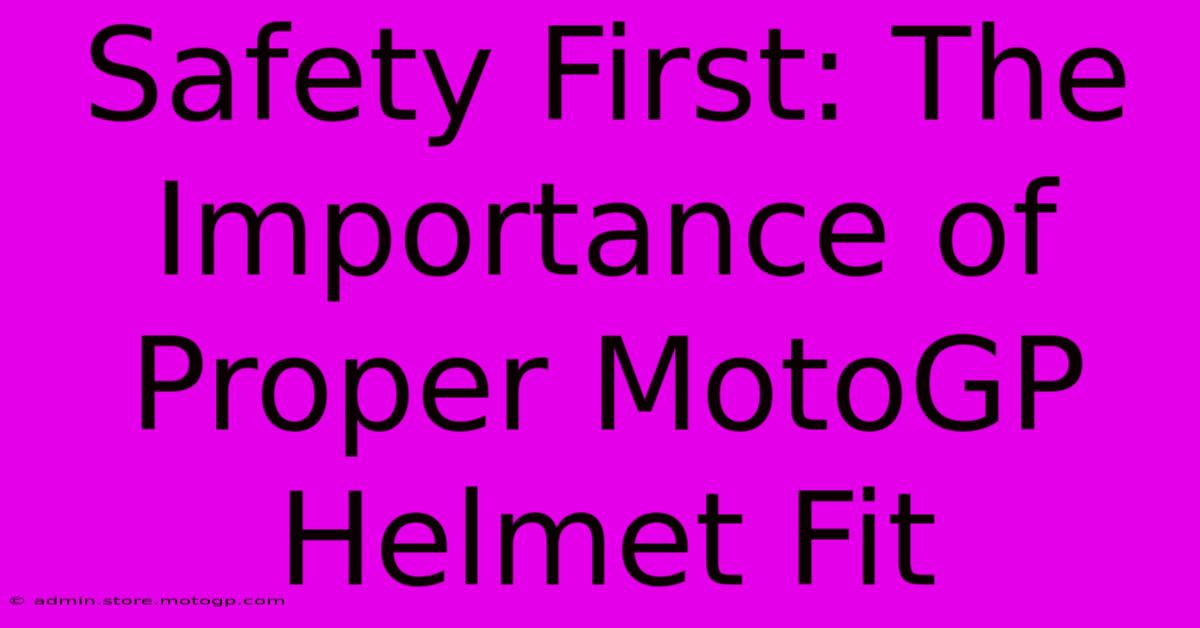Safety First: The Importance Of Proper MotoGP Helmet Fit

Table of Contents
Safety First: The Importance of Proper MotoGP Helmet Fit
For MotoGP riders, the helmet isn't just a piece of equipment; it's their lifeline. A proper fit isn't just about comfort; it's about survival. In the high-speed world of professional motorcycle racing, a poorly fitting helmet can mean the difference between a minor injury and a catastrophic accident. This article explores the critical importance of ensuring your helmet, whether you're a professional racer or an enthusiastic weekend rider, fits correctly.
Why Proper Helmet Fit is Crucial in MotoGP
The intense forces experienced during a MotoGP race demand a helmet that provides unparalleled protection. A helmet that's too loose can shift during a crash, leaving vulnerable areas exposed. Conversely, a helmet that's too tight restricts blood flow, compromises vision, and can cause discomfort leading to fatigue – all critical factors that negatively impact performance and safety.
The Consequences of a Poorly Fitting Helmet:
- Increased Risk of Head Injury: A loose helmet can easily rotate or come off during an impact, drastically increasing the risk of serious head trauma, including concussion, skull fractures, and even death.
- Compromised Vision: A helmet that's too tight can obstruct peripheral vision, hindering a rider's ability to react quickly to changing track conditions or other riders.
- Neck Strain and Discomfort: An ill-fitting helmet puts undue strain on the neck muscles, leading to fatigue and potentially impacting riding performance and safety.
- Reduced Aerodynamic Performance: A helmet that shifts during high speeds can disrupt the rider's aerodynamic profile, impacting their speed and stability.
Finding the Perfect Fit: A Step-by-Step Guide
Finding the right helmet fit requires careful consideration and attention to detail. Don't rush the process; your safety is paramount.
1. Measure Your Head:
Accurate measurements are the foundation of a proper fit. Use a flexible tape measure to determine your head circumference at the widest point, usually just above your eyebrows.
2. Try On Different Helmet Sizes:
Most helmet manufacturers offer a range of sizes. Try on several helmets within your measured size range to find the most comfortable and secure fit.
3. Check for Key Fit Indicators:
- Snugness: The helmet should feel snug but not uncomfortably tight. You should be able to comfortably fit a finger between your temple and the helmet padding.
- No Pressure Points: Pay attention to any pressure points around your temples, cheeks, or forehead. These can become extremely painful during a long ride or race.
- Secure Chin Strap: The chin strap should be snug enough to prevent the helmet from shifting, but not so tight that it restricts breathing or blood flow. The double D-ring closure should lie flat against your chin.
- Vision: Ensure the helmet doesn't obstruct your vision in any way. Check your peripheral vision to make sure your line of sight is clear.
4. Consider the Helmet Liner:
The liner is crucial for comfort and fit. Some liners are removable and washable, allowing for customization.
5. Get Professional Advice:
If you're unsure about which helmet size or type is right for you, consult a specialist at a reputable motorcycle gear retailer. They can help guide you through the process and ensure you find the perfect fit.
Beyond the Fit: Maintaining Your Helmet
A perfectly fitting helmet is only as good as its maintenance.
- Regular Cleaning: Keep your helmet liner clean and dry to prevent the build-up of bacteria and odors.
- Inspect for Damage: Regularly inspect your helmet for any cracks, scratches, or other damage. A damaged helmet should be replaced immediately.
- Helmet Lifespan: Helmets have a limited lifespan, typically around 5 years. Even if it doesn't show visible damage, it's advisable to replace your helmet after this timeframe.
Conclusion:
A properly fitting helmet is the single most important piece of safety equipment for any motorcycle rider, especially in the demanding world of MotoGP. By following the steps outlined above and prioritizing safety, you can significantly reduce your risk of injury and ensure you're prepared for whatever the track throws your way. Remember, a perfect fit isn't just about comfort – it's about survival.

Thank you for visiting our website wich cover about Safety First: The Importance Of Proper MotoGP Helmet Fit. We hope the information provided has been useful to you. Feel free to contact us if you have any questions or need further assistance. See you next time and dont miss to bookmark.
Featured Posts
-
Cota Parking Map Never Get Lost Again
Feb 19, 2025
-
Get The Most Out Of Cota The Detailed Austin F1 Map
Feb 19, 2025
-
F1 Parking Everything You Need To Know About Parking
Feb 19, 2025
-
Moto2 Demystifying The Specs
Feb 19, 2025
-
Understanding The F1 Grid From Formation To Lights Out
Feb 19, 2025
